-
April 15 1875
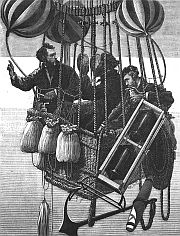
Zénith balloon tragedy
On this day in 1875, pilot Theodore Sivel, engineer Joseph Croce-Spinelli, and civilian Gaston Tissandier, took off in their 3000 m3 balloon 'Zenith', from La Villette gasworks in Paris. The trio were able to reach a record-breaking altitude of 28,000 feet.
Although the men carried bags of oxygen-air mixture aboard the Zenith, Sivel and Croce-Spinelli both died of asphyxiation (hypoxia), when the balloon reached extremely high altitudes. Tissandier survived, but became deaf as a result of the flight. He subsequently founded and edited the scientific magazine La Nature and wrote several books. -
April 17 1912
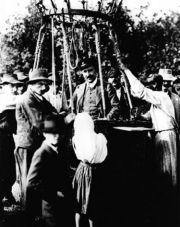
Victor Hess discovers cosmic rays
On this day in 1912, Victor Hess an Austrian physicist made an ascent to 5300 metres in a balloon during a near-total eclipse of the Sun and discovered the so-called cosmic rays. He made a series of ascents starting in 1911 to take measurements of radiation in the atmosphere, looking for the source of an ionizing radiation that was registered on an electroscope and was first believed originating on rocks. In 1911 his balloon reached an altitude of around 1100 metres, but Hess found "no essential change" in the amount of radiation compared with ground level. On the eclipse flight he found that the ionization of the atmosphere did not decrease, so he reasoned that the source of the radiation could not be the Sun: it had to be coming from further out in space. Hess shared the 1936 Nobel prize in physics for his discovery.
-
April 29 1949
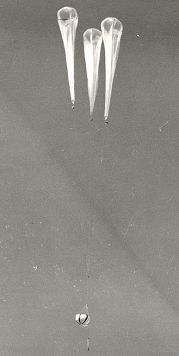
Test flight of a balloon-borne free-fall platform
On this day in 1949, was performed from Holloman AFB, a test of the Free Fall Test Vehicle (FFTV), a development by the Office of Naval Research Special Devices Center to create a free-fall test platform.
On that times, supersonic wind tunnels were a scarce commodity in high demand so one alternative method of data-gathering was to drop test bodies equipped with experimental airfoils and other aerodynamic test equipment from high-altitude balloons.
As the design of balloons was incipient at the time, and there were no balloons available of the size required, a cluster of three Skyhook plastic balloons, seventy-three feet in diameter when fully inflated, were used to lift the FFTV to 100.000 ft.
The balloons were connected to the fifteen foot long projectile by a tether system and included an inverted parachute to slow the ascent. -
April 22 1959
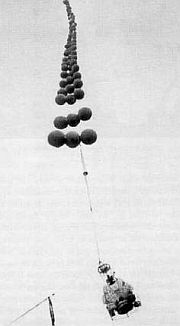
Astronomical observations from 43.000 ft by Audouin Dollfus
On this day in 1959, the French astronomer and aeronaut Audouin Dollfus performed an ascent to 43.000 feet in a sealed cabin and using a cluster of sounding balloons.
The system lifted Dollfus from Villacoublay, France, shortly after sunset. Consisting of 105 balloons attached to the 1.500 foot line in clusters of three at a separation distance sufficient to accommodate their final diameter of about 30 feet. The lightweight gondola, a 230-pound sphere of thin metal about six feet in diameter, was sealed, pressurized, and air-conditioned.
During the flight, the balloon system stabilized at an altitude of about 43,000 feet. For over three hours Dollfus studied the moon and several planets, chiefly Venus. He used a polarizing spectrophotometer designed to filter and measure the intensity of the 1.4-micron band of water vapor in the planetary atmospheres. An astronomical telescope of 50 centimeters diameter supplied light for the spectrophotometer.
Descent was initiated by severing 18 balloons from the top of the array and a safe night landing was acomplished. -
April 13 1963
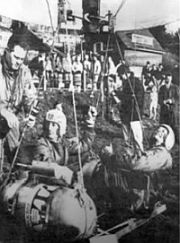
First hot air balloon flight across the English Channel
On April 13, 1963, pilots Ed Yost and Don Piccard crossed the English Channel in hot-air balloon for the first time in history. The pilots launched the 60,000 cubic foot hot air balloon "Channel Champ" from the village of Rye, England. Three hours and seventeen minutes later Yost landed the aircraft near Gravelines, France completing the historic voyage.
The Channel Champ was a further refinement of Yost's first models of hot air balloon developed at Raven Industries with the Office of Naval Research to create an aircraft that would carry one man and enough fuel to fly for at least 3 hours, carry a load to 10,000 feet and be reusable and require a minimum crew to launch. -
April 20 1963

Second STARGAZER flight failed to launch
On this day in 1963, during prelaunch preparations at Holloman AFB for it's second scientific mission, Projezt Stargazer balloon broke loose and soared away. Balloon was to have carried a gondola with Capt. Joseph Kittinger and astronomer William White, along with a telescope to study stars from above most of earth's atmosphere.
Apparently, sudden wind blew the moored balloon from side to side, creating static electricity which triggered a safety mechanism to release the balloon. The free-flying gasbag landed 120 miles east of the base. The damaged balloon was recovered and initially it was thought that it could be repaired. However, the mission would be never acomplished as two days later the incident, USAF announced the cancellation of Project Stargazer because of lack of funds. -
April 27 1963
Air Force balloon sets new load record
On this day in 1963 a 5.000.000 cubic feet balloon launched by the Air Force Cambridge Research Laboratories (AFCRL) from Chico, California set a new record for gross load with a test payload of 4500 lbs.
The balloon constructed of polyethilene of 1 mil thickness flew for 34 hours. -
April 9 1964

Reentry of the EXPLORER IX balloon satellite
On this day in 1964, EXPLORER IX re-entered the earth's atmosphere and disintegrated after more than three years in space. The lightweight, 12-ft.-diameter balloon was NASA's most effective satellite of the AD Explorer series. Their purpose was to measure the density of the upper atmospheric layers and counted with a beacon transponder for tracking. Placed in orbit in Feb. 16, 1961, EXPLORER IX traveled more than 340 million miles during its 14,000 orbits of the earth.
It provided a better understanding of upper atmosphere characteristics, determining more precisely the relationships between air density and solar radiations. EXPLORER IX was also the first satellite orbited by a solid-fuel launch vehicle (Scout) and the first satellite launched at Wallops flight facility.It provided a better understanding of upper atmosphere characteristics, determining more precisely the relationships between air density and solar radiations. EXPLORER IX was the first satellite orbited by a solid-fuel launch vehicle (Scout) and the first satellite launched at Wallops flight facility. -
April 30 1982
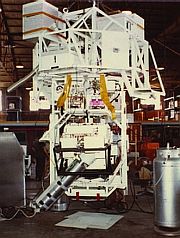
First data gathering flight for BAMM-II program
On this day in 1982, was carried out the first data-gathering flight in the Balloon Altitude Mosaic Measurements II (BAMM-II) Balloon Program. The balloon launched by the Air Force Geophysics Laboratory flew during 10 hours from Chico, California to near Pyramid Lake in Nevada.
Objective of the program was to make temporal, spatial, and spectral measurements of earth backgrounds in the infrared. Long term objective was to develop a technology to study background rejection capabilities of the staring mosaic concept against a number of "real" backgrounds as well as establishing the advantages of a mosaic technology to apply these technologies in a future Advanced Warning System to detect hostile missiles in flight from altitude. -
April 1 1983
Balloon launch facilities at Chico, California closed
On this day in 1983, the Air Force Geophysics Laboratory ended its leasing of their balloon-launching facilities at Chico Municipal Airport, California. The agreement was active since 1961 and allowed the realization of hundred of balloon flights mainly for test purposes. The facility located inside the Municipal Airport was a very active launch station for more than 20 years.
-
April 27 1984
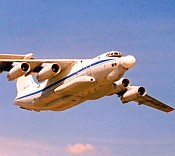
Soviet airborne laser system damage a stratospheric balloon over Volsk
On this day in 1984, a Russian A-60 airplane flying at an altitude of 32,800 feet damaged a balloon over the Volsk aerostat research center, using a laser gun.
The A60 special aviation system was developed in the mid-1970s at the Beriev Aircraft Company based on a Il-76MD transport airplane. As part of the work, two flying laboratories were created: the 1A and 1A2. While the details remain secret even today, what is known is that the A-60 system was the peak of the Soviet airborne laser program development. The laser gun was housed in the plane's cargo bay while on the fuselage spine, there was a large fairing, covering a mirror system, by which the laser ray was directed onto the target. The gun had a range of 25 miles and was able to "shoot" for about 11 seconds.
The 1A aircraft was lost in a fire at the start of the 1990s. -
April 10 1997
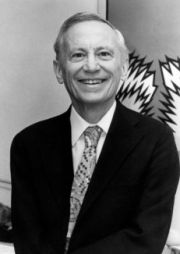
Martin Schwarzschild dies
On this day in 1997, Martin Schwarzschild, Princeton's astronomy professor emeritus died of a heart attack. He was 84 years old. Schwarzschild made fundamental contributions to the field of astrophysics through his study of the structure and evolution of stars. He won the Newcomb-Cleveland Prize of the AAAS in 1957 for Stratoscope I, a balloon-borne telescope that obtained the first sharp photographs above the earth's fluctuating atmosphere.
He also was involved in the development of Stratoscope II, a 36-inch balloon-borne telescope, that flew a number of times in the 1960's and early 1970's, bringing back near-infrared spectra of Mars and of cool stars and images of the nuclei of M31 and NGC 4151 unblurred by atmospheric seeing. Stratoscope was a forerunner not only of the Hubble Space Telescope but also of the Kuiper Airborne Observatory, because Schwarzschild and his collaborators were the first to exploit the fact that terrestrial water vapor is confined largely to the troposphere.He also was involved in the development of Stratoscope II, a 36-inch balloon-borne telescope, that flew a number of times in the 1960's and early 1970's, bringing back near-infrared spectra of Mars and of cool stars and images of the nuclei of M31 and NGC 4151 unblurred by atmospheric seeing. Stratoscope was a forerunner not only of the Hubble Space Telescope but also of the Kuiper Airborne Observatory, because Schwarzschild and his collaborators were the first to exploit the fact that terrestrial water vapor is confined largely to the troposphere.

